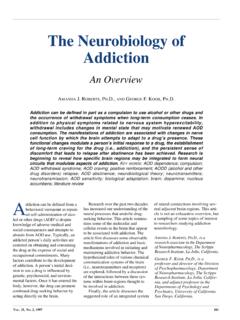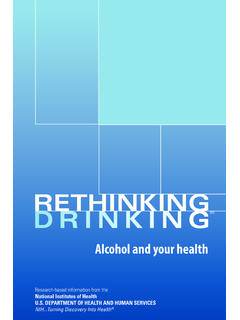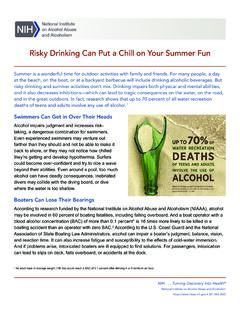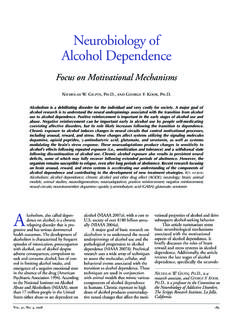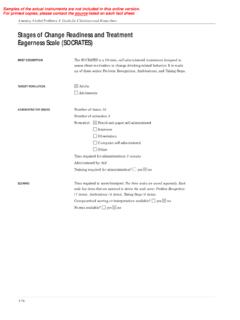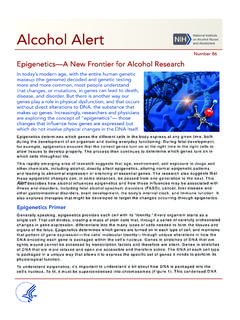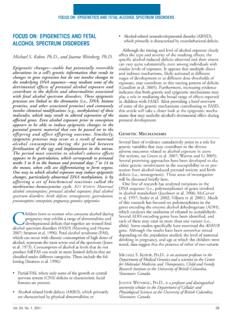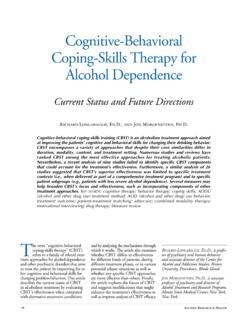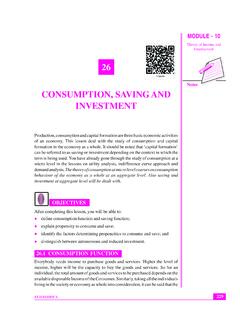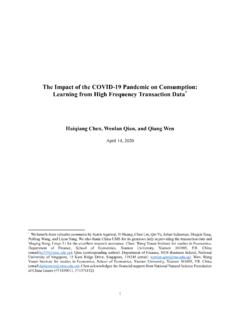Transcription of SURVEILLANCE REPORT #110 - National Institutes of Health
1 National institute on Alcohol Abuse and Alcoholism Division of Epidemiology and Prevention Research Alcohol Epidemiologic Data System SURVEILLANCE REPORT #110. APPARENT PER CAPITA ALCOHOL. consumption : National , STATE, AND. REGIONAL TRENDS, 1977 2016. Sarah P. Haughwout, Megan E. Slater, CSR, Incorporated1. Suite 500. 4250 N. Fairfax Drive Arlington, VA 22203. April 2018. Department of Health and Human Services Public Health Service National Institutes of Health 1. CSR, Incorporated, operates the Alcohol Epidemiologic Data System (AEDS). under Contract No. HHSN275201300016C for the National institute on Alcohol Abuse and Alcoholism (NIAAA).
2 Dr. Rosalind A. Breslow (Division of Epidemiology and Prevention Research) serves as the NIAAA Contracting Officer's Representative on the contract. (Blank page). HIGHLIGHTS. This SURVEILLANCE REPORT on 1977 2016 apparent per capita alcohol consumption in the United States is the 32nd in a series of consumption reports produced annually by the National institute on Alcohol Abuse and Alcoholism (NIAAA). Findings are based on alcoholic beverage sales data collected by the Alcohol Epidemiologic Data System (AEDS) from the States or from the National Alcohol Beverage Control Association, as well as from various reports produced by beverage industry sources.
3 Population data from the Census Bureau are used as denominators to calculate per capita rates. The following are highlights from the current REPORT , which updates consumption trends through 2016: Per capita consumption of ethanol from all alcoholic beverages combined in 2016 was gallons, representing a percent increase from gallons in 2015. Between 2015 and 2016, changes in overall per capita consumption of ethanol included increases in 33 States, decreases in 12 States, and no changes in 5 States and the District of Columbia. Analysis of overall per capita alcohol consumption by Census region between 2015 and 2016 indicated an increase of percent in the Northeast, percent in the Midwest, percent in the South, and percent in the West.
4 Healthy People 2020 set the National objective for per capita annual alcohol consumption at no more than gallons. Per capita consumption would need to decrease by percent each year for the next 4 years to achieve this goal. In 2016, the overall per capita annual alcohol consumption level was more than 10 percent above target (> gallons) in 29 States and the District of Columbia, 10 percent or less above target (> gallons) in 12 States, 10. percent below target ( gallons) in 5 States, and more than 10 percent below target (< gallons) in 4 States. INTRODUCTION baseline value of gallons per year to no more than gallons per year by 2020 ( This SURVEILLANCE REPORT on apparent per capita Department of Health and Human Services alcohol consumption in the United States is the 2012).
5 According to NIAAA (2010), a 32nd in a series of reports that examine alcohol standard drink in the United States contains consumption trends on a National , State, and fluid ounces of ethanol. Thus, the target per regional basis. Like previous reports on per capita consumption level of gallons of capita alcohol consumption , it is intended to ethanol equates to approximately an average of provide updated alcohol information for 448 standard drinks consumed by a person age policymakers, Health care providers, researchers, 14 or older in a year. and others concerned about alcohol issues. The current REPORT updates the 1977 2015.
6 Data presented in this REPORT are related to one alcohol consumption trends (Haughwout and of the National objectives set in Healthy People Slater 2017) with new data for 2016. Data are 2020 for alcohol consumption . Healthy People, presented in four tables. Table 1 presents a program initiated by the Department of National data on trends in beer, wine, and spirits Health and Human Services, establishes consumption as well as on all alcoholic benchmarks to promote longer and higher- beverages combined. Table 2 presents data on quality lives for Americans. The program's alcohol consumption for individual States for objective for alcohol consumption is to reduce 2016.
7 States also are ranked in deciles the National per capita annual alcohol according to annual per capita ethanol consumption level by 10 percent from the 2007 consumption . Table 3 presents the alcoholic 1. beverage sales and shipment data sources for revisions based on data received after the volume data presented in Table 2. Table 4 publication. The types of data sources used to presents data on consumption trends for each obtain alcohol consumption data are listed for type of beverage and all beverages combined years 2001 2016 in this REPORT 's data file for the States as well as for the four regions ( defined by the Census Bureau: Northeast, ).
8 Midwest, South, and West. Population Data DATA State population estimates for people ages 14. and older were obtained from the Centers for Alcohol consumption Data Disease Control and Prevention's WONDER. AEDS makes every effort to obtain alcoholic online query system, which provides bridged- beverage sales data from all States and the race population estimates produced by the District of Columbia, because sales data more Census Bureau in collaboration with the accurately reflect actual consumption of National Center for Health Statistics ( alcoholic beverages than do production and Department of Health and Human Services shipments data from beverage industry sources.)
9 2017). These data are used as denominators to States provide sales data in the form of volume calculate the per capita consumption figures. or tax revenue that AEDS converts to gallons by To make the trend data more precise, AEDS. using State tax rates. For 2016, AEDS received revises data published in previous reports when beverage sales and/or tax receipts reports from the Census Bureau makes revisions to its 39 States. AEDS also received spirits and wine population estimates. This REPORT updates the sales data for control states from the National 2010 2015 population estimates using revised Alcohol Beverage Control Association.
10 When bridged-race estimates of the July 1 resident State data were unavailable or unusable, population from the Vintage 2016 postcensal shipment data from beverage industry sources series ( Department of Health and Human (Beverage Information Group 2017a, b, c) were Services 2017). used as a supplementary data source (Table 3). This REPORT updates previous beer industry METHODS. shipment data for years 1995 2015 with barrels of 31 gallons (in thousands) figures. AEDS Conversion of Ethanol Content determined that barrels of 31 gallons (in AEDS uses an estimate of average ethanol thousands) figures would be more accurate for content in the alcoholic beverages to convert the use in this REPORT because the Beverage gallons of sold or shipped beer, wine, and spirits Information Group provides updated annual data into gallons of ethanol (pure alcohol) before for 7 years prior to the reporting year.
